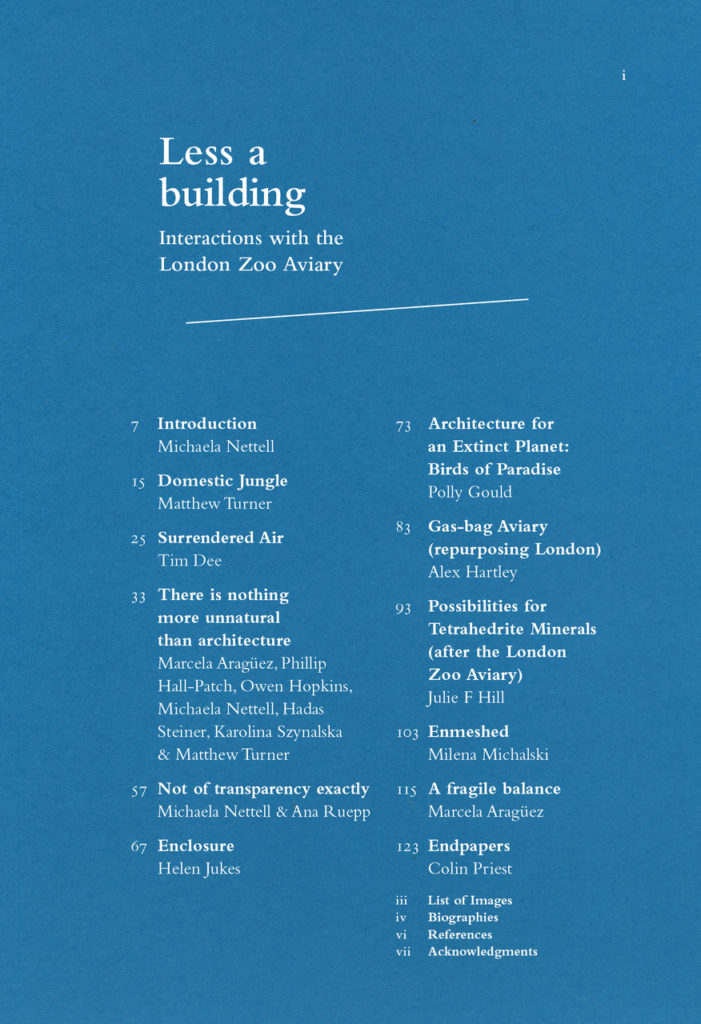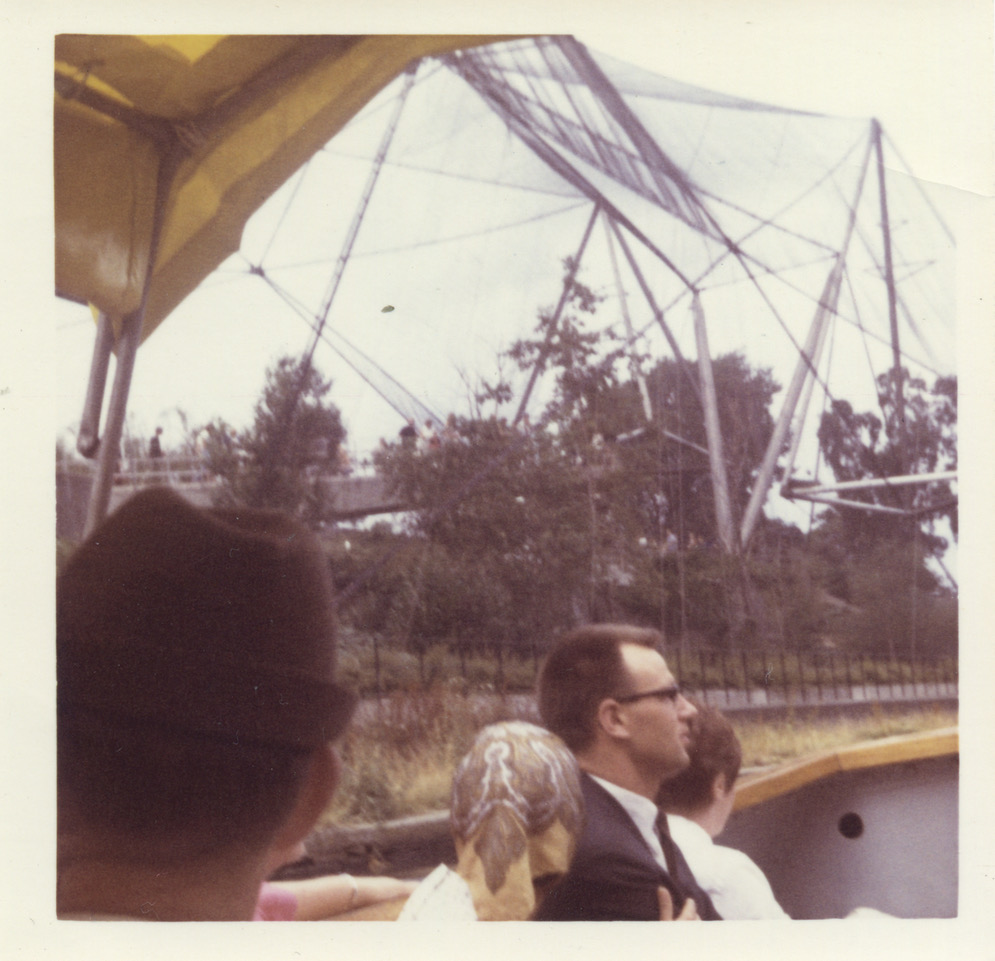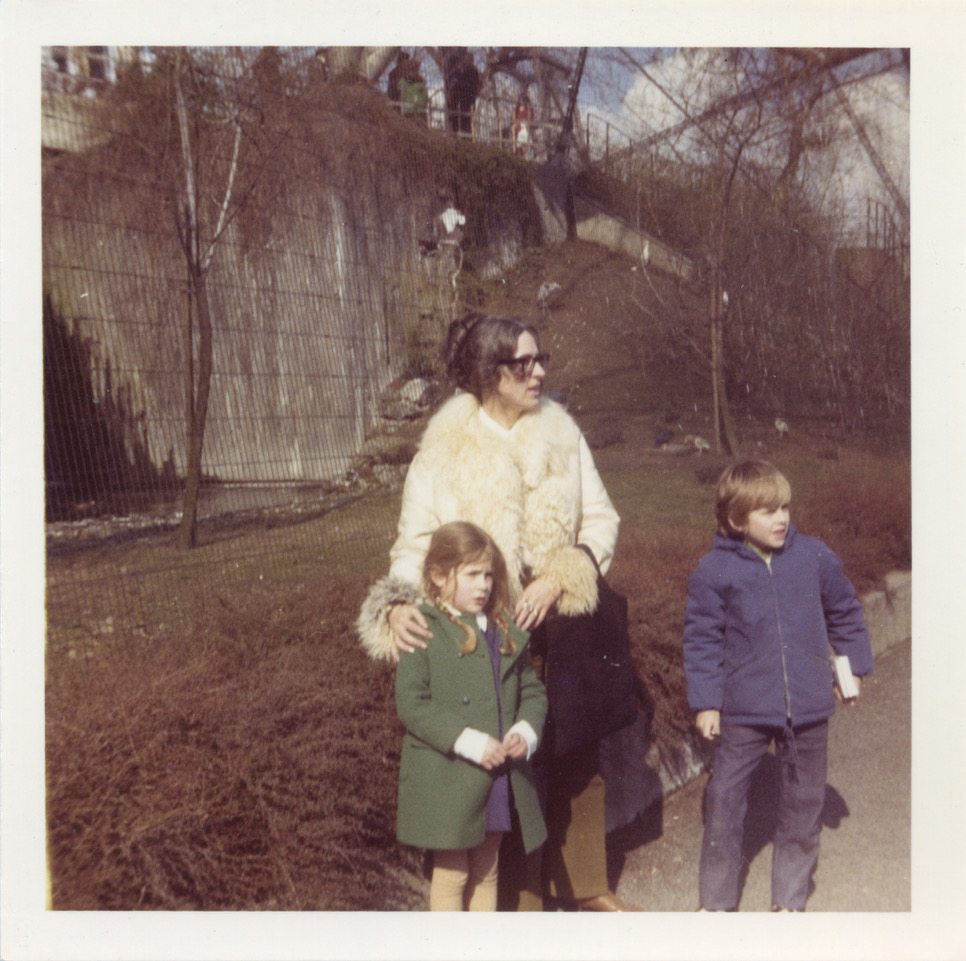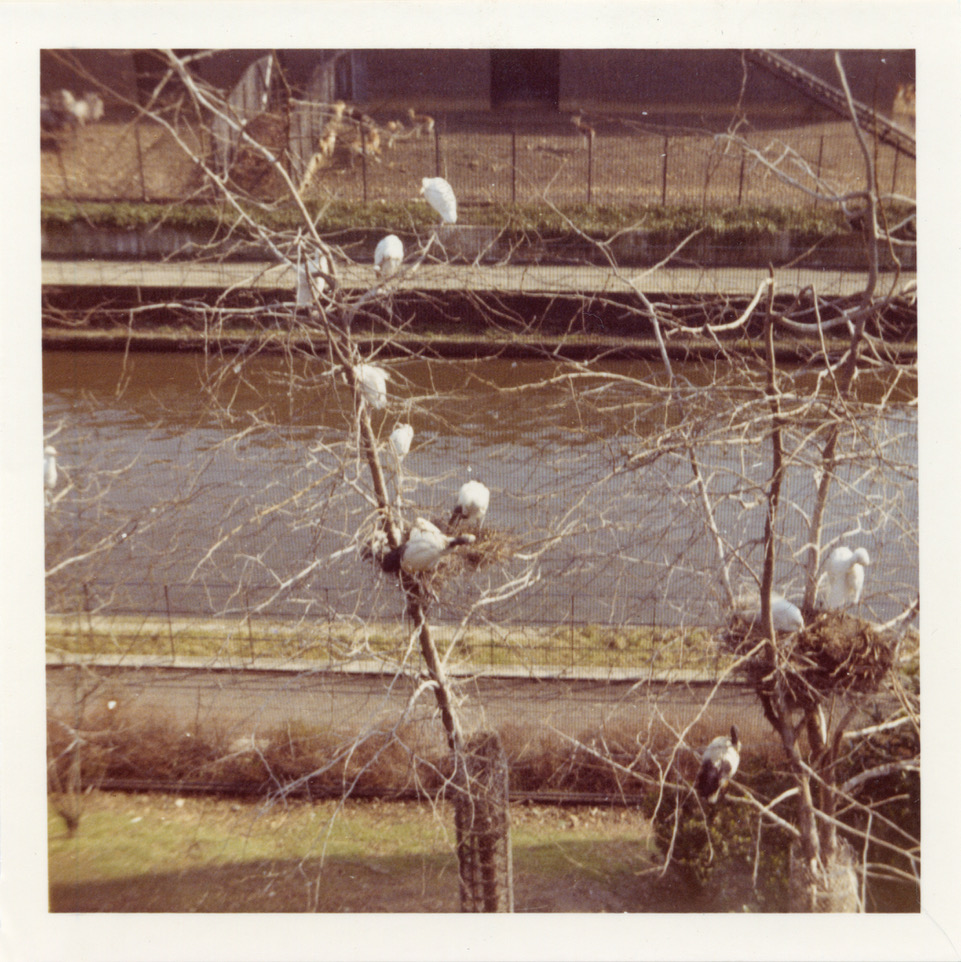In Michaela Nettell’s research project and publication ‘Less a building: Interactions with the London Zoo Aviary’, architects and writers consider the structure anew. Read Tim Dee’s contribution below.

A Robin Red breast in a Cage
Puts all Heaven in a Rage.William Blake
Though I don’t dare read them now, I loved the animal collecting stories of Gerald Durrell when I was young. Aged seven, I wanted to be him. In fact, I had wanted to be someone like him even before I knew there was a him to be like. I still have my first school writing book from two or more years before my parents, detecting a fixation, gave me A Zoo in my Luggage. My primary school teacher had encouraged a sort of proleptic CV: ‘I will be a zookeeper. I will get a lot of cages. I will collect lots of animals and get a lot of money.’
I went on to illustrate my future career with a picture in brown crayon: a smiling me walking arm in arm with an upright bear. Throughout my childhood I seem to have been angled towards the same destination. When I was about ten, I co-designed, with my cousin, Tom, an all-terrain animal-collecting vehicle for a much-fantasised safari into Africa. Our 4WD ark was to be called the DEENIC 2000 (Tom’s surname is Nichols; 2000 was a watchword in 1970 for technological futurity) and it contained, so the key to our drawing explained, many ‘Packaway Cages which Packaway’.
In the midst of these recurring dreams, my first visit to the Snowdon Aviary came like a happy sleepwalk. I was especially keen on birds by then and, at the zoo, I was thrilled to step through the aviary at one with its residents, sharing their space, the wire nicely beyond us both. It was a new species of cage for me: roomy as well as airy, and fashioning, at least, a suggestion of the once wild lives of its inmates. The modern angular line of the machined-metal building (though I knew, even then, that building wasn’t really the word) made it look like a 3D diagram or a hanging mobile – the idea of flight was being rendered by the structure as well as real wing-flaps sanctioned within it. I understood that, even as a boy.


Walking through the aviary it felt as if some of the sky itself had been trapped. I can’t remember what dominated the species mix on that first visit. Perhaps it was then the quarters of some scarlet ibises. I recall a fiesta of pink plumes, I think, and loud voices and lots of legs and bills – something, anyway, that made a visual rhyme with the gangling lift-off sensation of the giant airy cage.
I loved the aviary that time. I bought the idea, I suppose. Everything about it seemed somehow progressive, as if all was travelling, as birds appear to fly, into the future. But such benignity didn’t last and, on subsequent visits, my feelings shifted. By my mid-teens cage had come to seem something like the opposite of bird, an anti-rhyme; while today, forty years on, I am pretty much against everything that might go by zoo.
You might think that as a birder (which I still am) the chance to get close up with some of the subjects of my chase would always be welcome. Shouldn’t I put aside worries about the degradation of captivity in favour of some eye-to-eye intimacy? The last time I was in the aviary an Inca tern was happy enough to perch on a handrail less than an arm’s length away from me and there was a bald ibis not much further off. They were good to see without the (always distancing) magnification of binoculars. I also understand the life-saving value of captive breeding for some of the threatened species kept in cages like those bald ibises. I’ve seen them and the choughs and Meller’s ducks in Jersey Zoo (as established by Gerald Durrell after his collecting adventures). But something still feels wrong, and, overall, I’d sooner these facilities, even those in enlightened holding stations, didn’t call up ghosts of the circus. I’m old enough to remember the saga when Goldie the eagle escaped from his cage at London Zoo when it was being cleaned. I’m also old enough to have ridden on an elephant and attended a chimpanzee’s tea party in more than one zoo. Consequently, I know zoos and cages almost always to be places of show business. And in the Snowdon, already by the second time I was there in the early 1970s, I was overtaken by a pained sense of what the birds in front of me no longer were – free and flying, flying free.
Since then, I’ve seen a bird market in Beijing with thousands of larks and finches and warblers and flycatchers crammed like involuntary stowaways into tiny bamboo cells. The just-about-still-alive trampled the newly-dead beneath their little bird feet. Not far away, I also saw some captive oriental skylarks – each now in its own cage, barely bigger than itself, as if it were clothed in a skeleton armour – carried by their human keepers to the gardens of the Temple of Heaven. In that exquisitely cultivated paradise, they were held aloft on sticks into the lower sky, to sing against one another, performing something of their surrendered wild selves.
I felt the same peering at the most recent caged bird I’ve seen: a cockatiel in a wire cage on a hospital ward in Somerset, where my sick father lay cooped up. It wasn’t just because of where it was that it cheered things down. All trapped birds do.
I can’t get out – I can’t get out.
Laurence Sterne’s caged starling in A Sentimental Journey
Birds seem the most pitiful of any caged animal – the wire curtails so much of the essence of them. On my visits to London Zoo, I was much less troubled by the jostle of flightless penguins in their open-air pool. All they had was Berthold Lubetkin’s concrete walks and a shallow bath but they seemed far less abject than the birds in the aviary.

That the roof of the aviary pretends, through the interstices of its metal netting, to suggest an opening to the heavens makes it the most egregious (the word comes from a Latin phrase meaning standing out from a flock) of all animal gaols. The flock in the aviary are permitted their full wings but allowed only to give mugged performances of their wild flights. Cages trap. We cannot think of them as indicating anything other than a victory of sorts. We’ve won. Whatever is caged has lost. So, vanquished, it is also our prize. But surrendered nature – denatured – is abject to see, like the chimps at tea.
Hope, Joy, Youth, Peace, Rest, Life, Dust, Ashes, Waste, Want, Ruin, Despair, Madness, Death, Cunning, Folly, Words, Wigs, Rags, Sheepskin, Plunder, Precedent, Jargon, Gammon, and Spinach.
Miss Flite’s caged birds in Bleak House
We all know why the caged birds sing. They want out, and away. Caging a skylark is like caging the sky – somewhere in us we know it is wrong to do, and we also know that ultimately it is impossible, it will not work as we would have it. Any house we make for a captured wild thing is a bleak house. The skylark might sing from its cage but it is not a skylark singing in the sky.
As a dare-gale skylark scanted in a dull cage, Man’s mounting spirit in his bone-house, mean house, dwells –
Gerard Manley Hopkins
Perhaps it is that being fallen ourselves, and grounded, we seek to bring down among us those who still fly. Maybe cages are part of the sad song we sing (and have done forever – it is one definition of our species), our own sad song of separation from everything else alive. We cannot rebuild Eden by wiring up the sky, but maybe cages help us understand freedom, as prisons are meant to do. Maybe the aviary describes freedom by showing its opposite; maybe we give meaning to flight by denying permission to take off.
A cage went in search of a bird.
Franz Kafka
At the Snowdon Aviary disappointment prevails, an air of surrender. Though the mesh of the cage allows the notional sky to pass through, the air itself feels stale, stale like the chopped up pieces of browning apple in the toucan’s bowl.
There is zoogeographical chaos: the South American terns, the sacred-type ibises that could be African or Asian or Australian, the bald ibis from somewhere dusty around the Mediterranean, and others too – a ragbag seems to have been dumped in an old prison.
The birds’ expressions look grim. They are not tamed, exactly, but have been broken by their confinement; close up many look stupid or deranged. They eat up their apple pieces and some even build nests, but, still, sadness comes off them.
The cage reeks. And it shrieks. It is a crate of tired protesters, a tideline of washed-up refugees. How little obvious filth there is in the wild, you realise, seeing how, once captive, everything fouls its own nest. How dirty birds can get. The cage then becomes part of our mess too. Some laying waste to the world. A department of landfill. The next virus could come from here, from this live animal market. A zoonosis from the zoo.
Apes-ma, apes-ma
You’re eating too much
And going to the bathroom too much, apes-ma And apes-ma,
Your cage isn’t getting any bigger, apes-maCaptain Beefheart
Yet when I went that last time to look again at the aviary, I couldn’t help but think the demi-ruin, as it was then, beautiful. It is beautiful, like a gasometer is beautiful, beautiful in its – now old – attempt to hold onto what modernity’s mind-set thought it could master but was not truly able to grasp. The aviary is a built blueprint of flight as well as a cage in which to contain some flyers. It looks like an invention of wings. It wants to suggest what it cannot fully permit. It is like an architect’s model or a stage set: half ghost-ship – the Flying Dutchman, the Ancient Mariner’s craft? – and half flying-machine – Leonardo’s helicopter, the fossil Archaeopteryx? Its makers knew the envy of the flightless for the airborne and attempted some air traffic control when thinking of the life of the skies. That last time I saw it, it showed all that, with pathos.
And then, bathos. As a child visitor, I saw house sparrows coming through the wire, into and out of the aviary. And I smiled to see something similar nearly fifty years on. Starlings, then, were doing what the sparrows of the 1970s had pioneered.
The ordinariness of their actions – familiar, casual, domestic – corrected everything somehow. It became clear to me that those birds were what the aviary was truly for, not for the scarlet or bald ibises or for us. The sparrows and starlings made a home in a place where many – gaolers and gaoled – had attempted the same but never succeeded. The little birds’ use of the cage, their making it work in their lives on their terms, made it a good and free space, even lovable, a habitable place.
*
Priced at £14.00, ‘Less a building’ is out now and available here. Caught by the River readers can cash in a 10% discount using code LAB10.